Luxury Travel Review

Our overnight stay at a Cape Town Waterfront luxury hotel
Article by Elena del Valle
Photos by Gary Cox
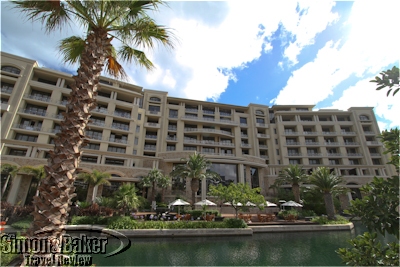
The One&Only hotel in Cape Town
We arrived by train in Cape Town at the end of the day on a Sunday. After we had finalized our itinerary we discovered the hotel we planned to spend the first night at was miles away from the city and to reach it we had to drive through an area under construction. Rather than drive unfamiliar roads under construction at night we opted to stay in the city. From among several choices, including two new five star properties, we chose the luxurious 131-room One & Only at the touristy and familiar V & A Waterfront area for our first night in the city.
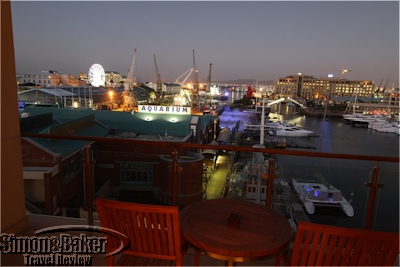
Looking out at the Waterfront from the room
We arrived a bit flustered because our rental car GPS didn’t list the hotel or accept its address and we missed the discreet sign of the One&Only as we drove by the building. On our second drive by we found the hotel. As soon as we entered the parking area a uniformed attendant, Charles, welcomed us and took charge of the rental car and luggage. Moments later, Kyle was guiding us through our check in process. We were greeted with a hot towel and soft drinks.
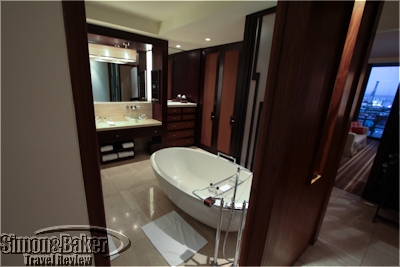
The large bathroom featured tub and shower
We were required to sign a registration form with a disclaimer that indicated the hotel was not responsible for guest property in the room and the hotel required a 1,500 rand reserve on each of our credit cards. No other property we had stayed at in South Africa or elsewhere had required we agree to such a disclaimer or required a signed credit card reserve. At my request my reserve was reversed on our departure the following day. Written confirmation of the reversal required two hours, the young man at reception explained.
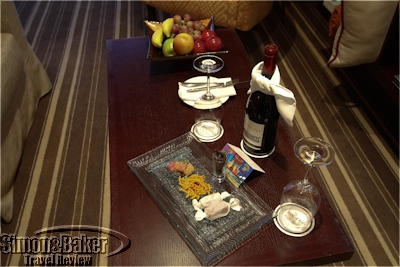
There were welcome amenities in our rooms
After we completed our check in Kyle kindly pointed out the main areas of the property and escorted us to our neighboring marina facing rooms (320 and 321). At my request our dinner reservations at Reuben’s (+27 21 431 4511), the hotel’s informal restaurant named for Reuben Riffel, a well known South African chef, were moved back 30 minutes to allow us time to freshen up and settle in our rooms.
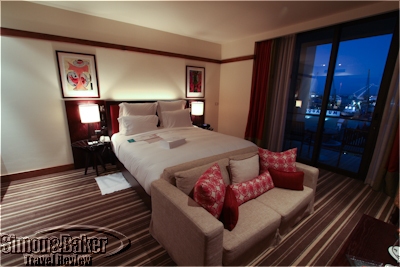
Sleeping and sitting areas in the spacious room
We liked that the pretty and spacious rooms shared an entrance foyer that could be closed (but not locked from the staff) with a hallway door for added privacy. After a few minutes we resolved, with the help of the hotel staff, a connectivity issue and went online. A few moments exploring my room revealed spotless, well appointed and air conditioned (the in-room materials explained that room temperature controls would be shut down while guests were out of the room) accommodations with two balconies, a large one with furniture one facing the neighboring Two Oceans Aquarium and the marina, and a smaller one facing the hotel spa and Table Mountain in the background. My travel partner’s room had one balcony facing the Aquarium.

The flavorful Chalmar steak at Reubens
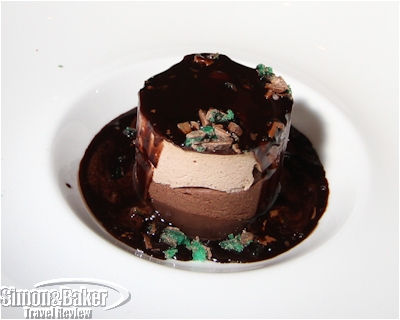
Dessert at Reubens
At Reuben’s, Dorothy welcomed us warmly and led us to our table for the night. The spacious two-story tall restaurant with a built-in three-level glass and steel wine storage wall housing 5,000 bottles and 600 references at the entrance and an open kitchen design was moderately busy. The highlight of dinner was my Chalmar rib eye steak, recommended by Lawrence Chiambah, our attentive waiter from Cameroon, when I asked about signature dishes.
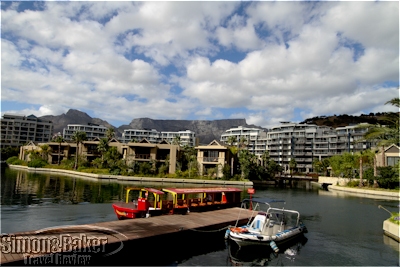
The water taxi just outside the hotel
With dinner behind us the excitement and fatigue of the day caught up with us. I longed for a steamy bath in my stand alone oval bathtub but settled for some time online and the speedy hot shower since we had an early breakfast followed by a spa morning. My room was blessedly quiet and the crisp linen beckoned me. I slept well on the comfortable bed. Due to our brief stay we had little time to enjoy our many room amenities and hotel facilities. Although I managed to take a swim in the pool before leaving there was no time for a work out.
We had a pleasant overnight stay at the service oriented hotel. Highlights included a pleasant (if loud) dinner at Reuben’s the night of our arrival, an ample and tempting buffet breakfast at the same venue the following morning and several indulging treatments each at the two-story One & Only Spa. Overall we were happy with our decision to relocate to a city hotel and with our choice of property, the One&Only Cape Town (Victoria & Alfred Waterfront, +27 21 431 5888, 1 888 877 7528, within the United States, +1 954 809 2751, outside the United States, http://oneandonlycapetown.com, reservations@oneandonlycapetown.com).
Constantia restaurant a popular special occasions venue near Cape Town
By Elena del Valle
Photos by Gary Cox
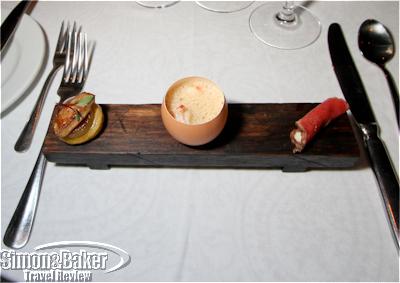
The tapas board
During our visit to the Constantia wine producing area on the outskirts of Cape Town, South Africa earlier this year we dined at La Colombe, a popular gourmet restaurant for many years. Its reputation preceded it. Securing a table on a Saturday night required advance planning before arriving in South Africa. The restaurant was located within the well known Constantia Uitsig Wine Estate. Although it was only a short drive away from our accommodations we made our way there thanks to our hotel’s courtesy transport so we wouldn’t need to drive and find our way back across the dark and unfamiliar roads following a lengthy tasting menu with wine pairing meal.
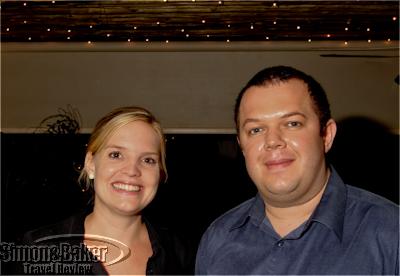
Johan, the restaurant manager and Faye, our server
When we arrived the well lit interior of the restaurant revealed a near full dining room. Johan, the restaurant manager, greeted us and moments later we were seated in a corner indoor table in the middle section of the restaurant. There were outdoor tables in a courtyard adjacent to a water feature on the other side of a set of sliding glass doors next to my seat. The staff used those doors for ingress and egress to that part of the restaurant and at times the movement was distracting.
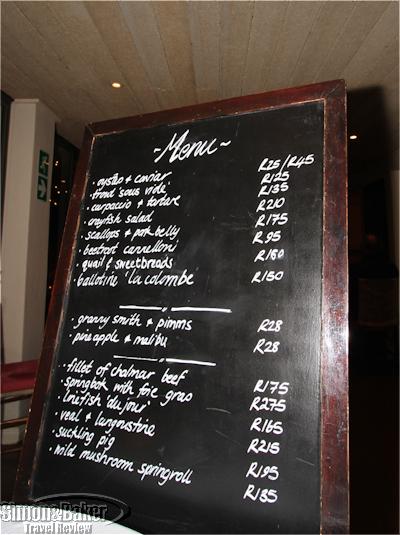
The menu board
After introducing herself our server brought the daily a la carte menu which was written on a black board. The eight course Tasting Menu with wine, with a cost of 850 rand (it was available for 625 rand without wine), we had was presented in a printout sheet.
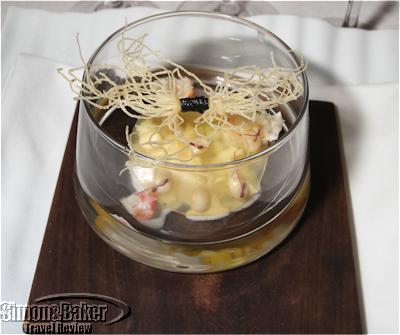
King crab with apple and crisp kataifi
After ensuring we were settled down with a glass of sparkling Constantia Uitsig wine and pre-appetizers and taking our order Faye, our server, returned to her other tables while we took time to observe our surroundings. From where I sat on an armless chair (less than comfortable) I could see part of the kitchen which was adjacent to the entrance area dining room. The restaurant appeared to be divided into three main areas: the entrance dining room, the central dining room where we were, and a courtyard dining area next to ours. The restaurant’s understated décor with earth tones was the first thing I noticed. I had the impression that we were sharing dining space with the many other guests in someone’s former home. Background music and kitchen sounds, reminiscent of an urban eatery (a bit too loud for conversation or romance), filled the air.
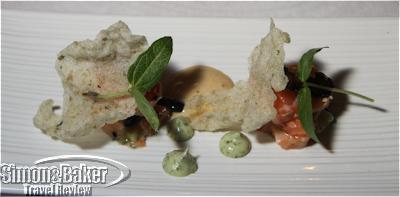
Salmon carpaccio and tartare
Our tapas of caramelized onion tart with foie gras, Thai seafood veloute, and beef carpaccio with mushroom gnocchi sat atop a wood board. There were three types of bread to temp us, sun dried tomato, French and seeded multigrain. Butter, balsamic vinegar and Willow Creek Virgin Olive Oil were available to accompany our bread.

Quail and foie gras
Our first dinner dishes consisted of Alaskan king crab, apple, cucumber, red onion and pickled ginger, kalamansi veil, lime dressing and crisp kataifi served with 2011 Constantia Uitsig Sauvignon Blanc. Next, there was a salmon Carpaccio and tartare, pickled shitake, avocado, red onion, ginger, yuzu, sesame foam, salsa verde and nori puffs served with 2010 Mellasat White Pinotage from Paarl. Ballontine of quail and foie gras, poached figs, fig dressing, hazelnut chocolate truffle and toasted brioche served with 2011 Cederberg Bukkentraube was next. There were too many flavors for us to enjoy the delicate foie gras taste. Then, there was a salty and crunchy dish of Scallops and confit pork belly, smoked parsnip puree, black forest ham veloute, crisp pork crackling, and lemon and pea dressing served with 2010 Sequillo White Blend from Swartland. A palate cleanser of Pineapple granite, Malibu jelly, and Piña Colada foam followed (a favorite).
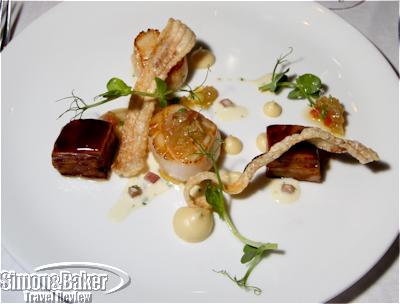
Scallops and pork belly
Pan fried springbok topped with foie gras on wilted baby spinach, roasted garlic, shimiji mushrooms, potato fondant and truffle jus served with 2009 Eikendal Charisma from Stellenbosch was next. It was followed by a cheese dish of Pecorino crème Catalan, red onion and port jelly and caraway biscuits. Dessert of Smoked chocolate torte, hazelnut semifreddo, cognac marshmallow, coffee meringue, tobacco caramel served with non vintage Signal Hill Empereur Rouge Natural Sweet wine from Paarl completed the meal.
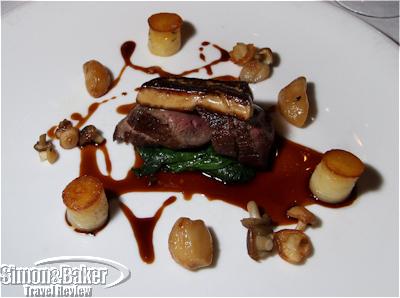
Pan fried springbok with foie gras
Staff were attentive. When a hapless fly dropped in my glass of wine our server replaced the glass with a fresh one. When guests stepped away from their table a staff member folded their napkins. Wines were served well and with care.

Executive Chef Scot Kirton
At the end of the meal, when things quieted down, we had a chance to meet Scot Kirton, the friendly executive chef who took over the kitchens in 2010. Our Tasting Menu was generous in the number of courses and rich in flavors and variety of ingredients (sometimes to the detriment of a dish). Some of the tables had rose petals strewn about indicating the occupants were celebrating a special occasion. The sold out restaurant evidently remained a popular choice. La Colombe, Constantia Uitsig, Spaanschemat River Road, Constantia, Cape Town, http://www.constantia-uitsig.com/pages/restaurants/la-colombe.php, lacolombe@uitsig.co.za
Outstanding seaviews in popular whale watching Western Cape cliff path
By Elena del Valle
Photos by Gary Cox
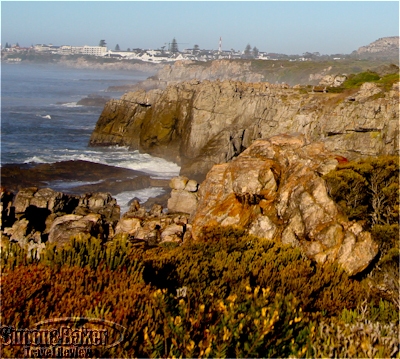
The cliff walk offered dramatic views of the ocean and cliffs
One of my favorite walks in South Africa is in the Western Cape. During our last visit to Hermanus we would walk the Cliff Path Nature Area daily for a couple of hours enjoying the stunning vistas and hoping to spot a whale, any whale even if it was not whale viewing season. Just as the sun was about to rise we would walk from Birkenhead House, a small hotel in Voelklip, west through the residential area of Kwaaiwater into central Hermanus on the marked and guarded (by uniformed security company staff) path which hugged the coast for miles, part of the Fernkloof Nature Reserve. During our walks, we saw a variety of coastal plants and birds, dassies (said to be a tiny relative of the African elephant), teenage seals and unexpectedly two brides whales which, according to the townsfolk, were a rare sighting.
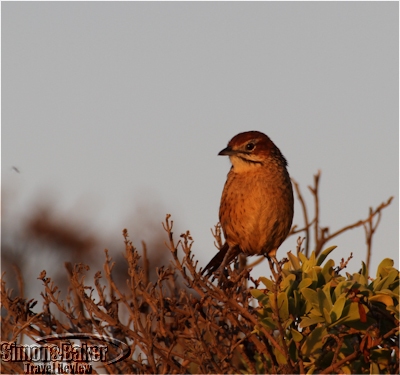
Shy little birds were out at first light
Occasionally small markers would point the way and large IFAW (International Fund for Animal Welfare) signs would provide information about the flora and fauna of the area including, of course, the whales that Hermanus is famous for nationally. In addition to the signage there were rubbish bins and indications that someone in the municipality cleaned and managed the path on a regular basis. We also noticed designated parking areas at various places that intersected the walkway.
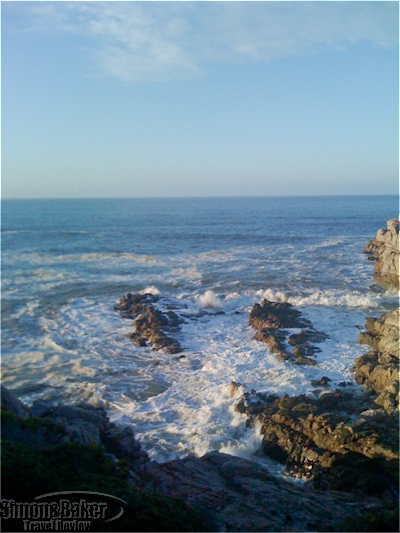
The waves constantly smashed into the rocky islands and shoreline

Seals climbed onto the rocky islands
The path passed steps below the rear terrace of our hotel and continued past Hermanus along the coast. We found it ideal to depart just before sunrise. Earlier than that and it was difficult to see the unlit path clearly, risking a twisted ankle or fall, and loosing out on of some of the beauty of the scenery for lack of light. Much later than sunrise was less worthwhile in part because the bird viewing and photography light were best early in the morning. From a comfort perspective as the sun emerged the light quickly became harsh and, although the ocean breeze was pleasant, the summer sun was punishing causing us to tire prematurely.
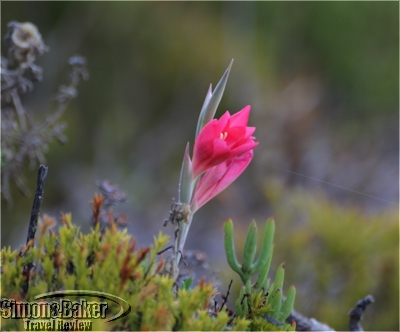
Small colorful flowers brightened the fall landscape
Along the way, benches were scattered at strategic spots where we could stop to enjoy the sea views. From the cliffs we could observe the crashing waves, copious quantifies of sea kelp, a variety of birds and coastal views of the upscale area. Adjacent to the walk there were beautiful houses in varied styles and sizes and as we neared the town there were some small buildings too.
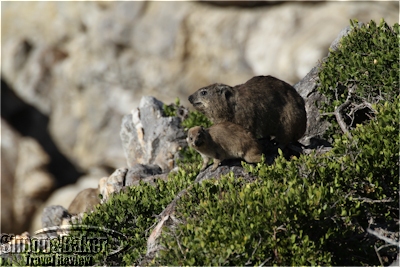
A dassie family perched on the rocks
We often crossed paths with locals out for a walk or jog, sometimes in the company of their unleashed dogs. Most of the paved walkway was built within a natural area surrounded by greenery and flowering plants passing through beaches, up cliffs and across bridges. There was a less attractive segment that veered inland on a sidewalk for a few minutes along the well trafficked main road before returning to the waterside and reaching central Hermanus. On Marine Drive, in the central part of town and across the street from the bay, we discovered Yves’s Pudding & Pie (87 Marine Drive, +27 082 924 0920), an informal spot to stop for a quick savory bite and cold beverage. We especially liked the pies.
Wanosato ryokan a healing place for this road weary traveler
Article and photos by Joachim Castellano
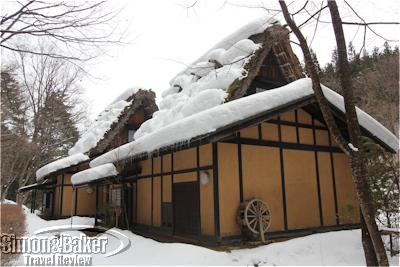
I arrived in the middle of winter
Visitors to Japan often make similar observations. I could treat myself to a decent shopping spree if I collected 100 yen for every time that I’ve heard, “Japan is clean! The people are very courteous! Japanese food is delicious!” In addition to positive responses, I have noted other surprises “Hotels here have small rooms. Trains sure are crowded.” And here’s my favorite, “I didn’t expect to walk so much!” With Japan’s excellent public transportation, people can cover the country and its massive cities with relative ease. However, for travelers used to touring by car, exploring Japan on foot can be unexpectedly tiring. Adding small hotel rooms to the mix can produce an even more tired traveler in Japan.
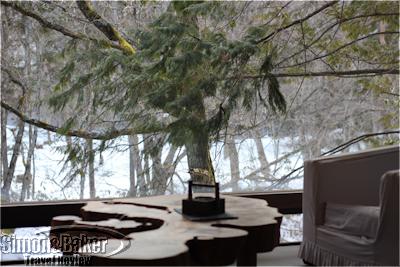
View from my room
For these reasons, a visitor’s experience in Japan would be incomplete without lodging in a ryokan, a Japanese inn. Ryokans offer much needed refuge from the road, and have comforted weary travelers in Japan for hundreds of years using the same formula: a healthy Japanese dinner and breakfast included with the room charge, spacious rooms, a warm public bath, and a fluffy Japanese futon spread on tatami-matted (bamboo reed mats) floors. Ryokans provide a wonderfully Japanese way of relaxing and recharging.
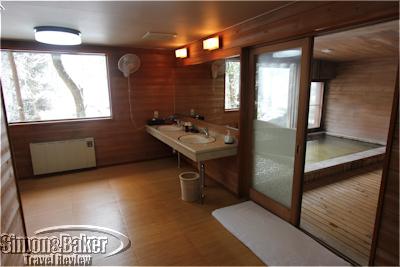
The men’s communal bathroom
While ryokans are very similar in service and amenities, none are constructed in cookie cutter fashion like many western hotel chains. A ryokan charms its lodgers with its unique characteristics related to design, location, and history. Some have been serving customers for hundreds of years while others have opened recently, designed in contemporary architectural styles, sometimes even blending Japanese customs with foreign ones, such as Arcanza Izu, which I previously wrote about (see With video – modern Japanese ryokan Arcana Izu creates magic in the mountains.)
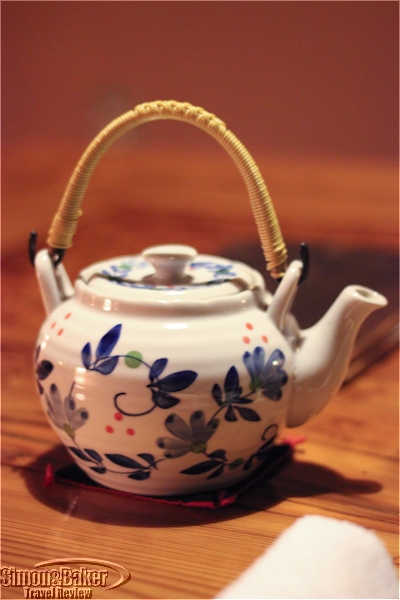
I had tea to warm the soul in the large lobby area.
For my friends exploring east and west Japan, I recommend staying at Wanosato, a delightful traditionally styled ryokan, at the crossroads of Japan. Little did I know at the time that I became part of a historical pattern of travelers seeking refuge in central Japan, where Wanosato is located. For thousands of years, travelers crossing the eastern and western power centers of Japan passed through what is now Gifu Prefecture. Lords, samurais, merchants, and other vagrants lodged at ryokans before resuming their journeys.
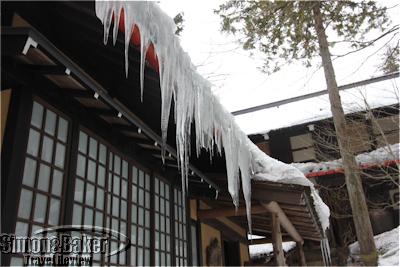
Wanosato icicles
To reach Wanosato I departed Tokyo Station for Takayama Station, near the Ryokan. After about a five hour train ride I took a 20-minute shuttle arranged by the inn. The driver pointed out the traditional architecture in the area and the Japanese Alps in the distance. Days before I had just been frolicking on sun kissed beaches, and now I was transported to an icy-world, blanketed with freshly fallen snow. I certainly could use some rest.
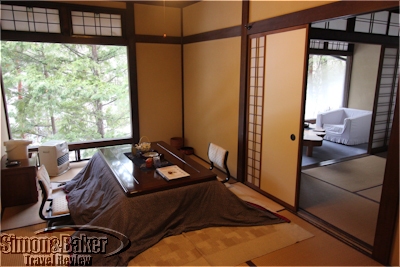
The sitting area in my room
I could have been fooled by Wanosato’s construction which took place only twenty years previously. The buildings were modeled after traditional Japanese architecture that emphasized nature. No concrete or steel there. Instead, buildings had distinctive thatched roofs on the outside and earthen floors and exposed wood on the inside.
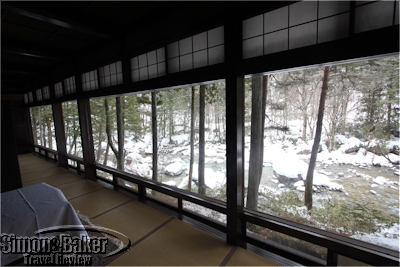
One of the main dining rooms features large panes of glass
When I entered the lobby of the main building I felt as if I had time traveled back to an era of samurai. The lobby was rectangular, framed by wood beams that appeared strong and beautiful. A raised hearth in the center warmed the room with a gentle fire while a massive iron pot rested above its flames. I sat on the tatami mats bordering the hearth and sipped on freshly brewed plum tea while I checked in. There was enough space around the hearth for well more than seven samurai.
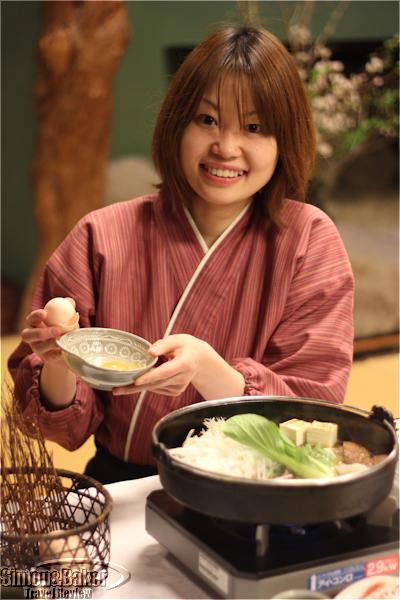
Aya Tochimoto took great care of me
I had not been feeling well upon arrival. With the first sip of Wanosato’s warm tea I felt calmness envelop my body. At my first dinner, I told Aya Tochimoto, one of the two English speaking staff members, about my health condition. After that, I felt as if I had been taken under the wing of a caring family. She adjusted the menu to include gentle foods. For the first two days I was confined mostly to my room. However, Aya constantly checked on my condition and asked if I needed anything. Despite being low on energy, I felt that a steady diet of traditional Japanese food, cooked with locally grown vegetables and freshly acquired meat and fish, and daily dip in the ryokan’s beautiful public baths couldn’t hurt.
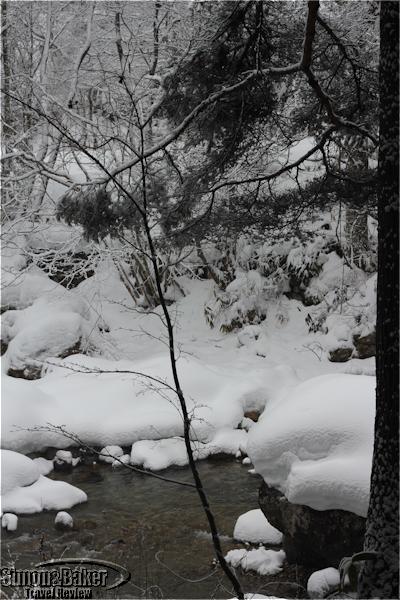
The Miya River
Eat, bathe, sleep, relax, repeat. I couldn’t feel more at ease in my room. It was divided into three sections: a main room where I slept, a living room with a delightful kotatsu, a Japanese table with blankets to keep warm, and a bathroom. I spent a lot of time nestled in my fluffy Japanese futon watching the spectacular view of the Miya River across the ryokan. On the second day, snow fell gently, coating the trees along the river.
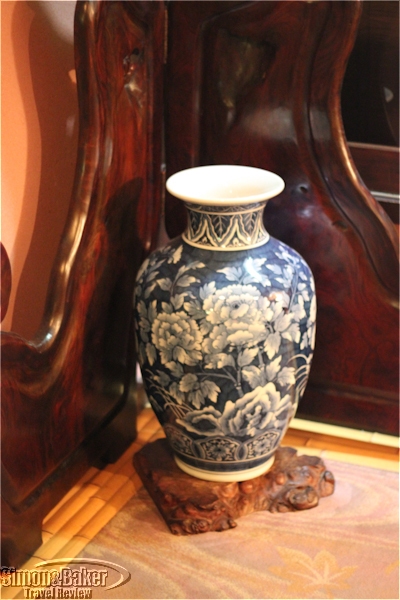
A beautiful vase on the third floor of the main building
On my third day, I finally felt enough energy to explore. I noticed fine examples of Japanese art throughout Wanosato. In the corner of the second floor hallway stood an exquisitely designed porcelain vase. In the main dining room hung elaborate scrolls. Next to the scrolls thought provoking ikebana, Japanese flower arrangements, stood proudly. Elaborate pictures were painted on sliding doors, making me pause contemplatively before opening them. On the way to the bath I noticed shisa, or stone guard dogs, whose slightly scary faces were thought to chase away evil spirits.

Mythical dogs were thought to drive away evil spirits
On the morning of my departure, I felt ready to hit the pavement again. The entire Wanosato staff accompanied me to the shuttle bus and bid me a safe journey home. The incredibly healthy traditional Japanese food, bone-warming baths, and the staff’s personal care energized me for my next adventure. Wanosato was exactly what this road weary traveler needed. Read more about my visit to Wanosato ryokan on the Simon and Baker Travel Review.
On domestic, international flights new carry on bag performed well
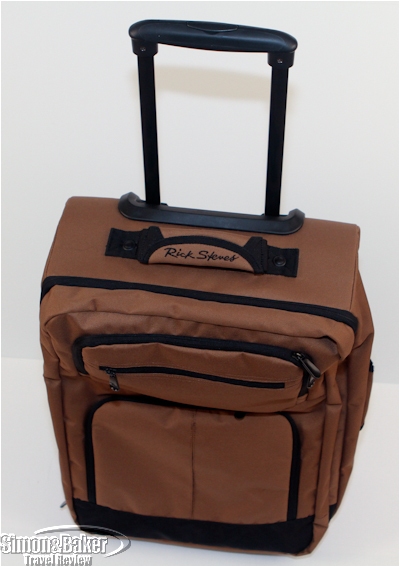
The Rick Steves rolling bag
In these days of airline luggage fees light weight high performance bags are more important than ever. We set out to test a light weight rolling carry on bag. We meant to order a regular Rick Steves carry on bag and instead ordered the new lighter weight Rolling Backpack that retails for $160. By the time we discovered the error it was too late for the first trip to Europe and we decided to try the bag since although we were not looking for a backpack it was light weight and small.
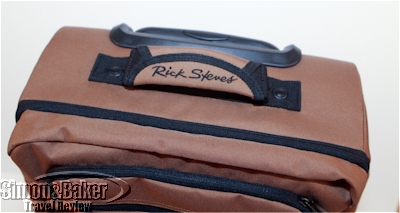
The telescoping handle enters smoothly into the recess
We were looking for a light weight carry on with wheels for an itinerary in Europe that involved multiple transfers in trains, planes and automobiles and later for a short domestic itinerary in which the carry on would be the primary luggage piece. This case with two wide-tracking wheels, 1,960 cubic-inch main compartment, telescoping handle and two outer zipper pockets was just the right size for our needs. It also had an air mesh on the back of the bag, a clip-in document pouch and zippered mesh lid compartment the length of the bag.
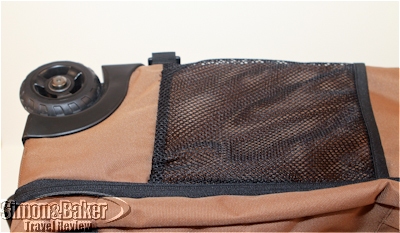
One side has a handle and the other a mesh pouch
At first it looked like the backpack bag would not remain upright but that issue disappeared once we packed some contents into it. Although we never made use of the backpack function (two straps were tucked handily in the back of the bag) the carry on case performed well on both trips. At 5.5 pounds it was light weight, easy to maneuver around train stations and airports and lift onto the carry on compartments on the planes. The 7 inch by 20 inch by 14 inch case fit easily in all travel spaces.
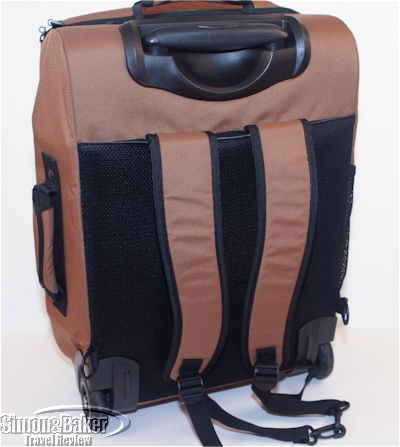
The backpack straps tuck into a pocket in the back
The recycled high density polyester fabric survived both trips without scratches or stains although it sat in the high speed train (TGV) luggage rack twice and in the airplane overhead compartments on six flights. It also got wet on several occasions and none of the contents including electronics like cameras and iPad became wet or suffered any ill effects.
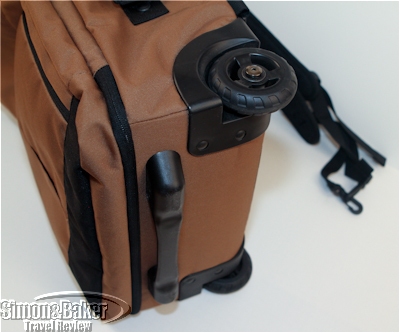
The foot in the bottom doubles as a handle
In both itineraries we were pleased with the bag. We will take it again on short domestic and longer itineraries in which traveling light of weight is a priority.
Watch video helicopter flight a favorite Cape Town sightseeing activity
Article, video by Elena del Valle
Photos, video editing by Gary Cox
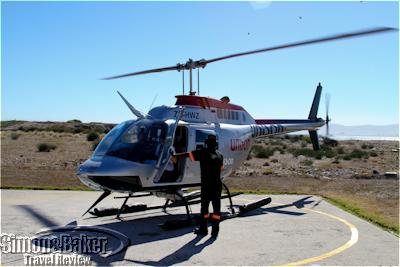
A pretty day for flying
Although each time we visit the fair city of Cape Town, South Africa it is a little more touristy than the last time we always leave enchanted. The setting between the ocean and the mountains is mesmerizing. Nowhere is that more evident than from above.
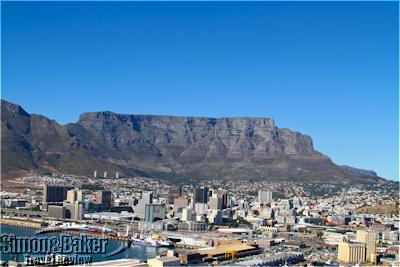
Cape Town and the famous Table Mountain
On our recent visit to Cape Town we went on an Atlantico Tour, a brief 18-minute (our camera time stamps reflected a 14-minute helicopter flight) scenic helicopter tour aboard a 1990 Bell JetRanger for up to four passengers (although we were the only ones aboard that day), with Nac Makana Aviation departing from a helipad very near the famed V & A Waterfront. It was a sunny, breezy and warm morning when we arrived. A friendly young lady at the front desk welcomed us when we walked in. Already there were a dozen or so tourists on the deck facing the departure area. Within minutes the staff had greeted us, weighed us and our hand held items and shared information about the flight. Next, someone provided a life jacket and led us to the helicopter, making sure we were strapped in and had our headsets on so we could communicate during the flight.
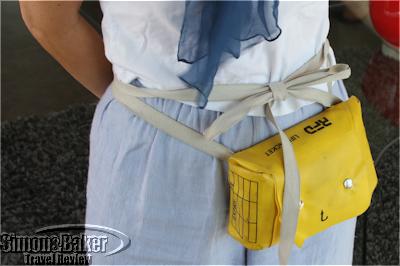
A life jacket for safety
Moments later we were airborne, flying over the waterfront and rising quickly above the cityscape. We flew toward Constantia Nek and returned via the Southern Suburbs; this routing, we learned later, was offered weather permitting to allow visitors to see more of Cape Town. Guy Douglas, our pilot with 800 hours of flying experience, made sure we were comfortable and left us to enjoy the view, pointing out the sights occasionally. No sooner did I recognize what an area was and focused my camera on it that the next beautiful sight appeared. Our flight took us over the V & A Waterfront, the outskirts of the city, past Table Mountain, Lion’s Head, the new Green Point Stadium, Sea Point, the beaches of Clifton and Camps Bay via the Twelve Apostles mountain range to view Hout Bay, Constantia Nek over the Constantia Wine Lands and back via the residential areas of the Southern Suburbs.
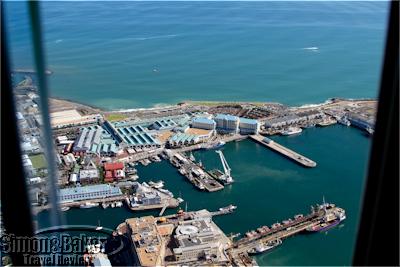
The V&A Waterfront from above
On our return we were whisked back to reception where a staff member offered us a glass of South African bubbly or water and a complimentary copy of Cape Town The Fairest Cape, a 22-minute tourist promotional DVD produced in 2010 by Bright and Gentle Television Productions and directed by Gary Wilson, general manager, NAC Makana Aviation. Atlantico Tour, NAC Makana Aviation, East Pier Road, V&A Waterfront, 8001, Cape Town, South Africa, +27 021 425 3868, www.nacmakana.com, info@nacmakana.com
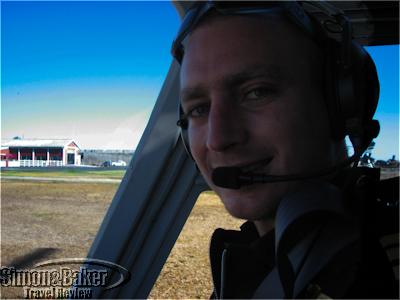
Our pilot Guy Douglas








